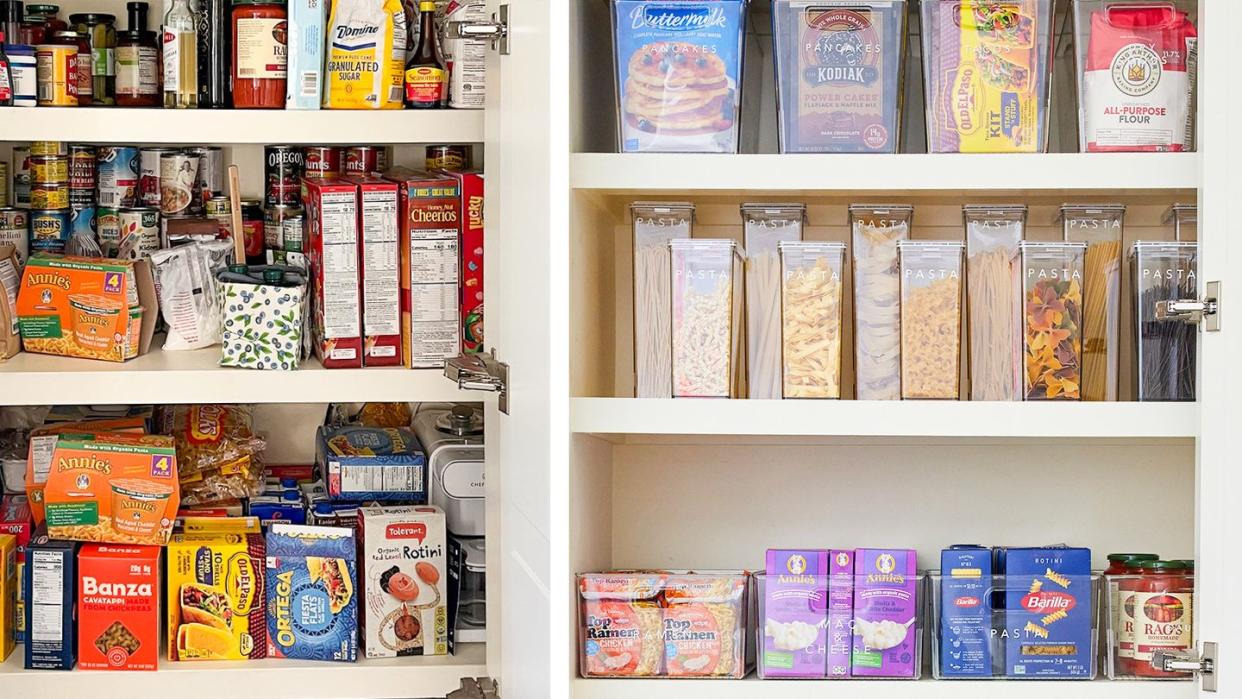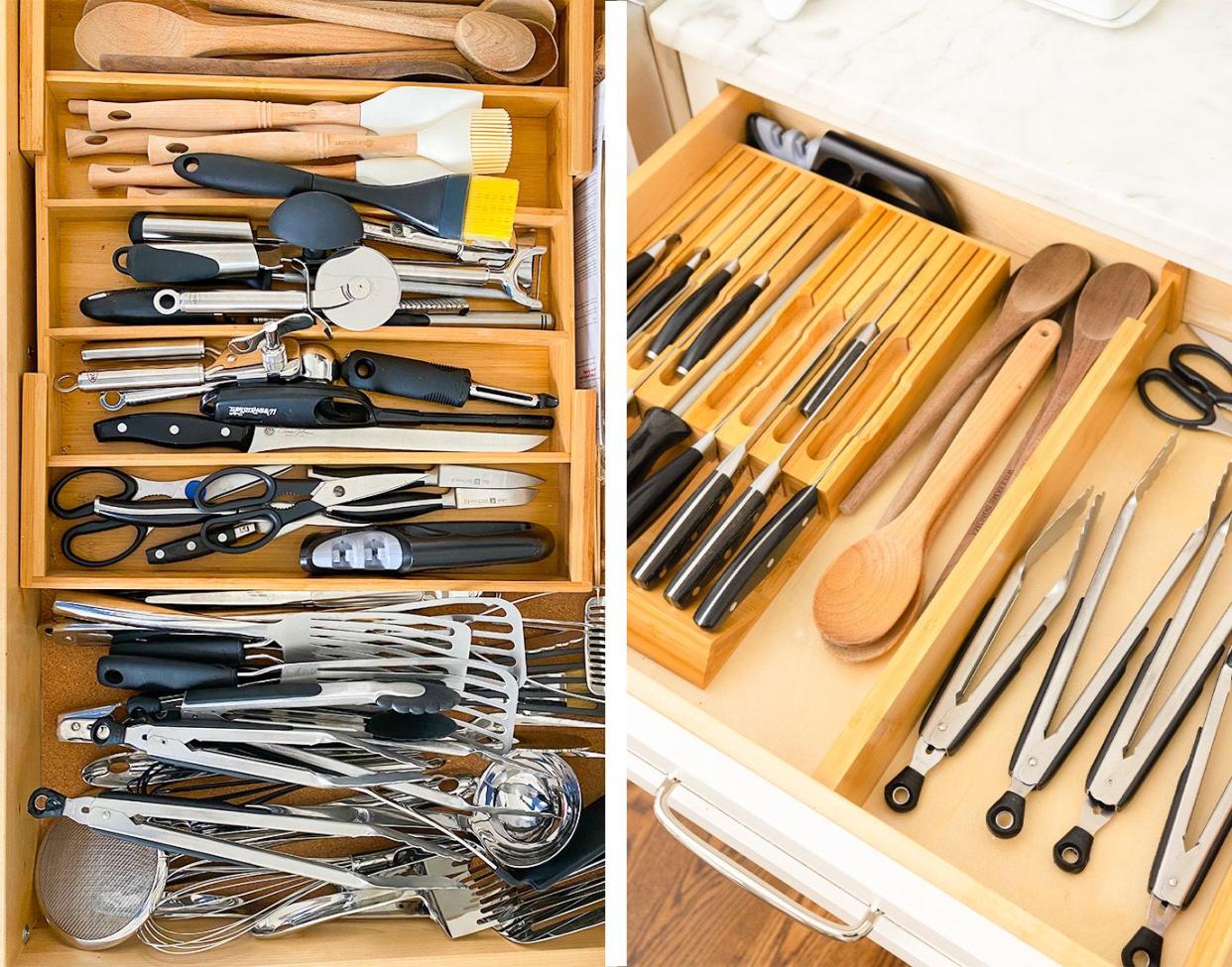This Is The Easiest & Cheapest Way To Organize Your Entire Kitchen

"Hearst Magazines and Yahoo may earn commission or revenue on some items through these links."
Scrolling through home-organization videos on TikTok might lead you to believe that you need to buy acrylic bins in bulk and put custom labels on every spice jar in order to unlock true organizational bliss. But the truth is, you can organize your kitchen without spending a ton of money on fancy storage systems. In many cases, you may even have some items on hand that can be repurposed to help you streamline your pantry and cupboards.
All of the aesthetic hacks on social media can be intimidating because they’re not exactly affordable for most people, says professional organizer Nicole Gabai, the founder of B. Organized and the author of The Art of Organizing: An Artful Guide to an Organized Life.
The secret to an organized kitchen comes down to a simple system: zones. A lot of times we make the mistake of assigning equal importance to all objects in a room, but it’s best to prioritize the things you use the most, Gabai says. Your “zone one” items, the utensils or cookware you use most, should be pretty much at your fingertips, while the things you use less often can be in zones two or three, she explains. Zone three might be something like a sous vide machine you only use a couple of times a year that’s stashed in an upper cupboard that requires a step ladder to reach.
Here are a dozen more tips from professional organizers that will help you get your kitchen in tip-top shape this spring (and beyond).
1. Create ‘Zones’ In Your Fridge
The idea of zones helps you keep a consistently organized kitchen. Meredith Goforth, the founder of House of Prim, a style-focused organization company, recommends having zones in your fridge, too—a dairy section, an area for drinks, a leftover zone, and so on. Zoning your pantry will also help everyone in your household know what goes where, she says.
2. ‘Everything Should Have a Home’
No matter if you have a small kitchen or a massive one with a walk-in pantry, the same rule applies: Everything should have a home, Goforth says. Take inventory of any duplicates you might have. If you’ve somehow accumulated five whisks, but only need the extras for an annual baking party, go ahead and put the remaining ones in storage. Clutter, she says, takes up mental space.

3. Decant As Soon As You Haul Your Groceries Inside
Bulky boxes can take up a ton of space in your pantry, and you can’t easily see how many granola bars you have left when you’re taking inventory before a grocery run. Goforth recommends decanting when you get home from the store. Take a couple extra minutes to pull items out of the box and store them in existing bins. That way, you always know when you’re running low on a pantry staple.
4. Use Mason Jars for Dried Goods
“The best budget-friendly way to organize your kitchen is simply to use what you have,” says Shantae Duckworth, a professional organizer and the founder of Shantaeize Your Space.
For example, use mason jars or existing glass containers to store dry goods like rice, pasta, and beans, she says. You don’t need an expensive labeling system either—something like washi tape will do the trick!
5. Repurpose Egg Cartons
Similarly, you can turn egg cartons into storage, Duckworth says. They’re great for stashing small items like little bags of spice-seasoning mixes or tea bags, she says. Bonus: They’re easily stackable.
6. DIY A Storage Bin
You can also use cardboard boxes or shoe boxes as bins to hold snacks or group dry goods, Duckworth says. Her pro tip: Cover them in decorative paper or fabric to create DIY drawer dividers for organizing kitchen utensils, gadgets, or small pantry items.
7. Make Smart Use of Vertical Space
You can also use household items to help maximize the vertical space in your kitchen, Duckworth says. She recommends installing shelves, hooks, or racks on the walls or inside cabinets. Tiered shelves in your pantry will help you see your canned goods and risers can help you stack more plates in a cabinet.
8. Use Turntables
Turntables are definitely a smart investment for an organized kitchen, says Heather Aiello, founder of The Organized You. They are very helpful to use in tough-to-reach corner areas, and you can use them in pantries, cabinets, or under the sink. They can hold anything from condiments to spices, or cleaning supplies, she says.
9. Invest in a Tiered Spice Rack
Or, use a drawer insert to organize spices in a drawer, Aiello says.
“Label the tops of spice jars for easy identification, and periodically declutter by discarding expired or unused spices,” she says.
You can also use turntables in cabinets to hold spices or oils.
10. Install a Tension Rod to Hang Spray Bottles
The area under the kitchen sink often becomes cluttered with cleaning supplies, trash bags, and other miscellaneous items, Aiello says. The tension rod can make use of vertical space to hang cleaning supplies, she suggests.
11. Do a 5-Minute Nightly Tidy
Once you’ve organized your kitchen, how do you keep it in tip-top shape? Spend five minutes at the end of everyday on a closing shift. Use this nightly routine to clear counters, put away items in their established zones, and wipe down surfaces, says Melanie Summers, founder of I Speak Organized.
“This small habit keeps the kitchen orderly day after day,” she says.
12. Take Inventory
Keeping a clutter-free kitchen helps reduce food waste because you’ll be able to easily see what ingredients you have. Before grocery shopping, a quick inventory of the pantry and fridge helps use up existing items, avoid duplicates, and plan meals around ingredients that need to be used, reducing waste and keeping the kitchen organized, Summers says.
You Might Also Like
